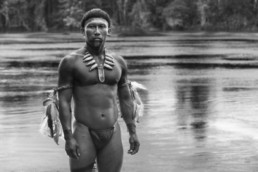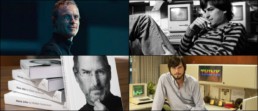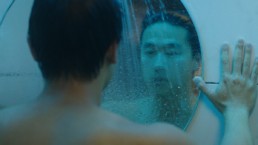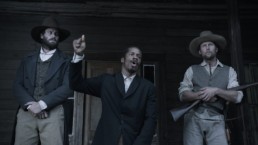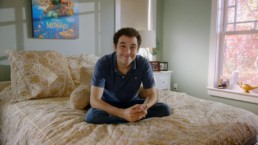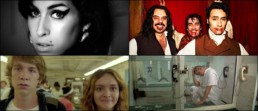Ancient and Modern Worlds Clash in 'Embrace of the Serpent'
The festival darling turned foreign film Oscar contender, Colombian adventure drama Embrace of the Serpent, is undoubtedly one-of-a-kind. Borrowing from the distinctive black & white photography style of early 20th century South American visitors and neo-colonialists, the entire film paints the Colombian jungles with a distinctly colorless palette, giving every image a natural depth and mystery.
Two storylines follow the same protagonist Karamakate, an Amazonian shaman and only survivor of his kind, guiding two different white men to search for a rare plant deep in the Colombian jungle. It is better to know going into the film that these are the same character roughly 30 years apart because it isn’t immediately clear and much can be deciphered from watching his differences as a young man (played by Nilbio Torres) vs. an old man (played by Antonio Bolivar). The inherent conflict remains the same in the parallel storylines: the world of the ancients clashing with the modern. Considering the time period the film covers is roughly 1909 and 1940, few differences can be made between the two time periods: this is deliberate, because in comparison to the ancient legacy of the native people, this is merely a blip. The parallels between the journeys become the most compelling part of the story.
At a dense two hours, Serpent can feel long at times because there is so much focused on the mood and the subtlety it doesn’t always leave the viewer with as much to grasp. Similarly, some details pass by quickly that need to be noted in order to comprehend later sections of the film. A few distinct languages are spoken, primarily Spanish and an indigenous language, but for non-speakers it can be hard to distinguish the subtle differences that carry thematic weight. Viewing becomes easier as the film unfolds and reaches more narrative moments. The film is more focused on the protagonist grappling with his place in the changing world. We never see the ‘civilized’ world that all viewers of the film are a product of, but its weight is felt in profound contrast to the images of this ancient jungle, and the stories told by the indigenous peoples.
That being said, the photography is a true innovation and feels unlike anything we’ve ever seen in a narrative film. Press images may have you fooled into thinking this is a documentary because of the intentionally shot images that feel like archival work even though everything was shot for this film. This is a prime example of using elements to capture the essence of what message the film is trying to convey.
Overall, Serpent isn’t as emotionally moving as some of its fellow foreign-language nominees, like last week’s Danish drama A War, but it makes its mark in how unique of a look it has compared to any other recent release. Those who prefer a more clear narrative may not gravitate toward this film as it meanders like the rivers the characters follow, but audiences who love mood and thematic displays will undoubtedly embrace every picture that comes on screen during this film’s runtime.
"Embrace of the Serpent" is now playing at the Nuart Theatre and is not rated.
Jobs, Jobs, Jobs, Jobs: A look at the many interpretations of one man’s life
Prior to seeing Danny Boyle’s Steve Jobs at Telluride, I similarly felt indifferent to the life of Apple’s CEO. I knew the vague elements, but other than benefitting from the technology, I had no need to look further. After the electrifying experience of Boyle’s movie, I was intrigued enough to ask two questions: why were there so many high-profile Steve Jobs projects, and what made each of them different?
In the months since Telluride, I have seen Boyle’s movie one more time, watched the two other Steve Jobs movies, and even tackled Walter Isaacson’s official biography, a tome that’s over 500 pages. I’ve spent more time on Steve Jobs than I ever care to do again. It is now time to reflect on each individually, and how the four unique iterations intersect.

Steve Jobs (2015) - The Sorkin/Boyle Extravaganza
An officially recognized adaptation of Walter Isaacson’s book would indicate it is approved, but Tim Cook criticized it for being ‘opportunistic.’ You can read my full review here. There are certainly criticisms to be had of this unconventional biography, yet when all is said and done it was this movie that inspired me to dive into the rest of these versions. I am not sure the same would be true of any of the others. There is something so energized about the whole endeavor; Sorkin takes the complexities of Jobs and distills it into three 40-minute sequences. More specifically, each sequence features a confrontation between Jobs and a few of the important people in his life.
After reading Isaacson’s book, I saw the movie again and noticed the subtle moments taken from the book sprinkled throughout the movie. Jobs mocks Woz for looking at food in the vending machine. He washes his feet in the toilet. Little details in dialogue and character moments are taken from the book that pass by viewers who don’t know to look for it, displaying how well thought-out every detail is here. Because of the condensed timeline, this version takes the most artistic liberties. For example, Scully and Jobs never talked again after 1985, yet here they are shown meeting 3 times: hypothetical conversations to reflect their feelings in the years gone by.
Similar to The Social Network, I believe that this is more an attempt to capture essence and mood rather than an exact replication of the reality. Take the casting for example- Fassbender barely looks like Jobs, nor does he ever imitate him, but somehow he becomes him simply by bringing the intensity and mood of the character. Unfortunately, Steve Jobs was not successful commercially and, therefore, may miss out on being widely viewed. For the experience of watching these talented artists perform at the top of their abilities, I encourage everyone to find a way to check it out.

Steve Jobs (2011) – Walter Isaacson’s Definitive Biography
Despite its length, the stories within this massive book are compelling enough to always want to read another chapter. A book has the luxury of not having to pick and choose nearly as much as a two-hour movie. Therefore, there is an all-encompassing feeling in Isaacson’s book. Here we not only get the same story that we see in the other books, but we also hear about his work at Pixar, his relationships at home, his parents and sister, and in the final section we get to learn about each and every product’s creation in the post-iPod era. This is compelling because the history and transformation of Apple is something that affected consumers everywhere.
Despite being compelling, I don’t know how many people actually sat down and read this book despite its bestseller status because it was so darn long. Even though I felt like I flew through it, it still took me a month to finish.
The biggest message Jobs attempted to instill in his work was the intersection of art and technology. Computers prior to Apple did not have an emphasis on design, or more importantly, user experience. This hallmark set Jobs apart and helped Apple to evolve to where it is today.
Ultimately, the book is the most definitive of the adaptations due to its vast scope. Reading the book in the context of all these other pieces helped me come to terms with the complexity of human beings in general. The jury is out on whether he was a genius or not, and there is too much contradiction to know if he was a man of his values. Regardless, Isaacson’s book allows you to see enough of Jobs that you can decipher an opinion for yourself more than any individual film adaptation.

Steve Jobs: Man in the Machine (2015) - Alex Gibney Documentary
There is far more that makes this entry unique other than it being a documentary. It is the only film that reaches into the 21st Century while the others end when he returns to Apple. Steve Jobs: Man in the Machine is the only one to focus on his legacy, including footage of how much his death moved people worldwide.
Gibney is the most critical of any of the Jobs interpretations. Fortunately, none of the interpretations sugarcoat Jobs or attempt to hide his not-so-positive behavioral traits. It’s hard to ignore the irony that despite being so frustrated with being abandoned by his birth parents, he attempted to do the same thing with his own daughter. At times, Gibney’s documentary seems intent on simply uncovering all of Steve Jobs' negative, beginning with ripping off his best friend Steve ‘Woz’ Wozniak and ending with his maniacal approach toward finding a missing iPhone prototype in 2011. It definitely doesn’t help that all of the interviews seem to be people that he wronged in his lifetime, notably the mother of his estranged daughter.
Ultimately, the documentary’s biggest revelation is the irony that despite being a man who always proudly stood against the system, in the end, he became the system. As CEO of Apple, he was wealthy beyond imagination and yet made no attempt to be philanthropic. He proudly touted having a $1 salary, yet was involved in back-end stocks in a blatant attempt to make himself and other head honchos at Apple much richer. These are mentioned in Isaacson’s biography but not with the level of punch that Gibney gives them here. Again, we see the clunkiness in his quick life transition as discussed above. Despite his reputation as a tech god, we see in this film a lot of the corporate side of Jobs that isn’t pretty at all, nor does it align with the neat story of his earlier life. One thing missing from all of the interpretations is how Jobs transformed from being a rebellious young start-up creator to the mega-powerful CEO that he became (with both good and bad). None of the movies or the book smoothly transfer from these two distinct personas we saw in Jobs. Indeed, it is my belief that this was a rapid transition: upon retaking the position of Apple’s CEO in the late 90s, he burnt himself out trying to put everything in place (and was still CEO of Pixar for the beginning years), and this caused him to age, both in looks and attitude, drastically. None of these adaptations seem to recognize how distinctly different Jobs was in these stages: I would be interested to see a piece that dissects this transition.
From a crafts perspective, Gibney’s documentary is master-class non-fiction filmmaking, pulling out all the best tricks in the book and much more. It’s extremely persuasive and undoubtedly has impact.
The message is less about Steve Jobs and more a cautionary tale of what he created. The products we use daily have had a profound impact on the way society interacts, in many ways for the worse. Gibney goes as far as to compare our constant use of the iPhone to Frodo and the Ring. There’s a profound notion that perhaps Steve Jobs couldn’t interact the way most humans could, so he invented a new way to do so with technology. While every other adaptation of Steve Jobs ends on a positive, sometimes saccharine note, this one is a reality check that at the end of the day, Apple today is a mega corporation exactly like the ones Jobs initially hated. It’s easy to romanticize the legacy and products, but always remember to keep this in mind when viewing these stories.

Jobs (2013) The Straight Shooting Ashton Kutcher Biopic
Perhaps one fascinating observation of watching three movies is that each one chooses a different set of supporting characters to be the essential players. Of course, Woz is always one of the choices. But in this film, the most prominent supporting role is in early Apple investor Mark Markkula, a figure who barely appears in Boyle’s movie! Similarly, Steve’s daughter Lisa Brennan-Jobs is the focal point of Boyle’s film yet now reduced to a tiny supporting role. Joanna Hoffman makes no appearance here but is essential to Boyle’s film (played by Kate Winslet). The list goes on. We see that because of the complexity of the character, it is only possible to choose a few of his interactions needed to tell his story. Each one produces a different side of the coin: imagine choosing three or four people in your life to star in your life’s movie, then choosing a different set for another movie! In the case of the documentary, this makes it easy to be biased as all of the interviews were people who had primarily negative interactions with Jobs.
The primary criticism this film receives in comparison to the others is that it is too conventional. It plays like many biopics before it as a “greatest hits” story going from one big moment after the other, although still is primarily the same story arc ending in his return to Apple. What’s interesting is how viewers have wisened up to this conventional approach, and now prefer for biographies to take an unconventional route, most often when it comes to someone’s life story who we’re all familiar with.
Being conventional isn’t the only issue causing the film to feel mediocre. Many ideas or sequences are left unfinished. A conflict of Jobs lying to Woz about how much money they earned is established early on but never gets a payoff. In fact, their relationship never has a proper conclusion. An opening scene of Jobs unveiling the iPod introduces the film as a flashback: because we never return to Jobs this late in his life, it feels extremely tacked on and a mere excuse to show Kutcher dressed as the Jobs most of us knew. The film’s ending catches the viewer off guard because it doesn’t feel like the movie has been building to it. This feels like a situation where the focus was clearly on capturing these specific moments of Jobs instead of the overall picture.
Ashton Kutcher seemed like an odd choice for Steve Jobs, yet bears a striking resemblance at times. What Kutcher adds that none of the others express is Jobs’ famous stare, which is perfectly displayed throughout the movie. However, unlike Fassbender, he never seems like a man after control, and his moments of anger don’t have the same sincerity that Fassbender’s do. Admittedly I can’t judge the film as a viewer would without having read the book: despite not being an official adaptation, it takes out so much from the book that you wonder if they did any other type of research in writing the screenplay. Like Boyle’s Jobs, this one also attempts to layer in bits and pieces of Job’s life into the dialogue to cram in as much as possible. In Sorkin’s screenplay, they are subtle, here they’re a little more on the nose. There are lines of dialogue such as “What should we name our company?” Often times real stories with mediocre movies made about them are left as such. Perhaps all the Steve Jobs stories prove that even if the first attempt isn’t fantastic, there still may be room to try again.

Wrapping them all together
What is it that is so compelling about Steve Jobs? There is a clear narrative arc in his life that makes him perfect fodder for writers. Sorkin’s screenplay and Boyle’s stylistic choices make no attempt to hide the 3-act structure: a character who begins to rise to the top, is pushed all the way to the bottom, and then climbs to even higher heights than ever before. Even Isaacson addresses this in his book on page 219: “What prepared him [Jobs] for the great success he would have in Act III was not his ouster from his Act I at Apple but his brilliant failures in Act II.”
His story is appealing to businessmen, who can salivate at how he redefined so many types of business practice and achieved billion-dollar success. Artists can relish in his love for calligraphy and product design. Actors, as we’ve seen, can tackle just how brutal of a guy he was and his intense moments of conflict with everyone in his life. Tech geeks need no explanation. Jobs frequently references his love of the intersection of art and technology. Perhaps the sense that there is something for everyone intersecting within Jobs life has spawned so many imaginings.
Yet if I have taken away anything from this case study, it is that so often in the media we try to distill the lives of famous human beings into easily understood stories, as if 56 years of someone’s life can be understood in 2 hours. Steve Jobs can be viewed as a monster but also as a tortured soul and a genius. What I’ve found is that in looking at how many times I’ve seen Jobs be portrayed, I realize how impossible it is to try and summarize any person’s life. When it comes to the people you know, it is hard to find simple adjectives (especially negative ones) that wholly explain the person. The same is even harder when looking at oneself. Yet so often with icons and celebrities, we try and view them as characters in a story with simplified mannerisms and human desires. The complexity of Steve Jobs asks us to re-examine the way we’ve simplified historic figures as 100% good or evil, brilliant or insane, influential or ordinary. I am forever challenged to accept all people as complicated and impossible to define in broad strokes. I invite others to do the same, no matter how many versions of Steve Jobs' life you care to sit through.
'Spa Night' Shows Universality in the Culturally Specific
Considering how many festival attendees arrive from LA, it is rare to find a movie in the competition that is entirely based there, in large part due to the emphasis on finding new voices of cinema from elsewhere. And yet, there are so many untold stories to be discovered in LA: here is one of them.
Spa Night is billed as being a movie about a Korean teenager discovering his sexuality at the titular Koreatown spas, but it is actually a broader story of being a first-generation Korean-American and the trials that come with it. Joe Seo plays David, an only child to two Korean immigrants who are struggling to make ends meet as he prepares to apply to college and live up to his parents wishes. The film is much more about the unique and loving relationship David has with his parents, which is why the film flourishes. The truth is David’s sense of insecurity and strong desire to live up to his parents is relatable to anyone, so this movie encapsulates what director Ang Lee calls “Universality in the culturally specific.”


Spa Night director Andrew Ahn aims for ultimate authenticity and hits his mark. His characters and situations feel painfully accurate all throughout the movie, and I would imagine even more so for Korean-Americans. The film's alternation between social situations with the protagonists and private moments with the family allow for the audience to see the numerous ways these characters interact and portray themselves. As an insight into this world, this is a very eye-opening film.
The strength of authenticity also proves to be a weakness. Forgoing a musical score and shooting at a more muted pace means that at times it doesn’t feel like it’s moving forward at all. That isn’t to say individual scenes aren’t engaging, but based on the initial premise, it is expected that movement may happen faster than it does. Perhaps knowing that this film remains at a simmer for the duration will help viewers more thoroughly enjoy the artistic work.
Overall, Spa Night is a success and an artistic breakthrough, despite the fact that its pacing and restrained style may hinder it from general viewer interest. The city of Los Angeles has so many movies in production yet so few try to tell stories that are new discoveries, so for this alone Spa Night deserves recognition. Its attention to characters, environment, and reality are top-tier for a directorial debut, and my hope is that Andrew Ahn’s next work can elevate the overall story elements that are not as strong as the individual scenes.
Unflinching 'The Birth of a Nation' Reclaims Power From History
Sundance’s hottest ticket has arrived, and I managed to attend the World Premiere. The true story of slave-turned-preacher Nat Turner and his eventual uprising has been a passion project for actor Nate Parker for 7 years, and he finally quit acting 2 years ago to write, direct, produce, and star in The Birth of a Nation. The amount of love for this man and his work was palpable before the movie even began: it was clear there is something very special here and this was an audience ready for it.
The title is a reclaiming of the same title associated with the 1915 D.W. Griffith silent film. Griffith’s movie was the first epic of its kind but is a blatant and spooky glorification of the Klu Klux Klan from today’s lens. It’s been a blemish that can’t be concealed in cinematic history since its release. Nate Parker’s story repurposes the title as a symbol of how this country was built on the backbones of enslaved Africans and their unavoidable connection to a country founded on the pursuit of freedom. It’s a brilliant way to shelve Griffith’s film, which is an important movie for historical and cinematic study but like the Confederate Flag has no place in today’s world. Parker’s 2016 film most certainly does.
Turner was born a slave but early on was unusually taught to read from the Bible, and would grow up to become a preacher. Through studying the Bible while living in the midst of slavery (which as Parker put it, “allowed nobody to go to sleep without a guilty conscience”), Turner reaches a point where he can no longer stay silent about the cruel injustice that, in this world, is a daily routine. At a certain point, he is tired of the slave owners abusing scripture passages to make their slaves submissive and moves toward radical action as the only path to freedom.
Given the subject matter and time period of history, there is an unavoidable comparison to 2013’s 12 Years A Slave that anyone who has seen both films will feel. 12 Years director Steve McQueen is a masterful visual storyteller and his Best Picture winner is one worthy of all the praise it received. This may mean the impact of Nation is not as visceral, yet there is certainly great value in telling both stories. Interestingly, between the two films combined, 60 years of history are shown, further emphasizing the enormity of America’s slave epidemic. Parker is not as focused on visual thematics as McQueen was, but certainly has a knack for numerous storytelling devices. The music of this film distinctly divides up the scenarios at hand, hopping between three genres that each cue the audience when used. There is some great symbolism that comes into play connecting African history and culture with the slavery, as these slaves were only a few generations removed from their African ancestors. Undoubtedly, the film is in touch with numerous themes related to its religious and historical premise and utilizes them well to tell the story, a part of history that does not have a massive legacy. Compared to the general Sundance lineup, the scale of this film feels like a step above the rest; much of that is due to budget, but a significant amount has to be the intention of the craft.
One area where Parker shines is his depiction of the women in this world. I would advocate for calling this a feminist piece, which will get overlooked given its a movie where race is the forefront of the conversation. A slew of strong women play pivotal roles in the cast: Turner’s grandmother, mother, eventual wife, along with Mistress Turner, the white baroness of the plantation Nat lives on (Aunjanue Ellis, Aja Naomi King, and Penelope Ann Miller). Multiple other women are essential to the story as well. These women play a massive role in his life and are never reduced to bit roles. It’s a rarity for a male director to make so much room for prominent female roles (not to mention especially in a historical film).
Overall, The Birth of a Nation strikes a chord that the industry needs to feel right now and that the audience will experience upon its release. In the wake of #OscarsSoWhite and the lack of media representation, Parker’s unflinching telling of history invites the public to experience a part of this nation’s formation and legacy that may not be well known to the general public, and as Parker emphasizes, reflect on why it matters today.
'Belgica' Review: Raging Belgian Fun With Slamming Comedowns
While I haven’t seen previous work from Belgian/Dutch filmmaker Felix van Groeningen, whose last film, "The Broken Circle Breakdown," received an Oscar nomination, there is rich enough texture in his new film, "Belgica," to truly marvel at the craft and storytelling. A festival programmer introduced this film, one of Sundance’s opening night selections, with the following statement: “For the last few years, we have been trying to get the World Dramatic category as top-tier as our US Dramatic. This year, thanks in part to this film, I think we finally reached that.”
The title comes from the bar in which the film takes place. Two brothers come together to expand what was previously a hole-in-the-wall bar into a full-on destination with a massive remodel. As their dream version of Belgica comes to fruition, so do added layers of conflict that arise with the massive growth: trouble with the new crowds, women, drugs, and differences in opinion on the bar’s future. The standout is the photography, which utilizes a broad variety of motifs and themes to display the strife that the two brothers are experiencing. At the beginning when the bar is small, the film carries a red hue with intimacy and fun themes, and as the bar expands beyond their control the color schemes shift toward a harsh and cold blue. That may be the largest visual shift but throughout there are numerous deliberate lighting decisions made to subtly enhance the viewer’s understanding of these characters. At the beginning working at Belgica seems like the best thing in the world, and as we go on we see that it comes with a lot of baggage and pain, paralleling a heavy night of partying and drinking.
The film feels a bit long at two hours, especially as the experiences get less jovial. A few of the side stories don’t entirely pay off, and most of the bar characters don’t have enough time to get fully realized. At the end of the day, this story is about two brothers in different stages of life figuring out how to handle it in the face of their own personal troubles. a very watchable story in that they are each so compelling and realized. No matter how frustrating some of their choices are, we want them to succeed and find what’s best. It’s this type of character development that lets the film fly.
The characters in "Belgica" are each so compelling and realized that no matter how frustrating some of their choices are, we want them to succeed. It’s this type of character development that lets the film fly. As someone who loves locations as characters, the titular Belgica is, of course, a prominent character of its own- morphing and developing as the plot progresses just like any of the actor’s characters. For the experience of vicariously owning and living at a bar, which includes both raging fun and slamming comedowns, "Belgica" is a compelling piece that visually stands above the crowd.
Sundance Review: 'Life, Animated'
Director Roger Ross Williams shed light on the African evangelical invasion in God Loves Uganda. Openly admitting he needed to do something a little more light-hearted for his next film, his latest documentary, Life, Animated, is an entirely different project.
At the age of 3, Owen Suskind completely shut off from the world and became unable to communicate. His parents soon discovered that he had autism and may never be able to speak again, heartbroken at the thought of how the relationship with their son they had dreamed of may never fully exist. After trying many tactics with professional help, suddenly Owen became able to communicate through using Disney animated movies. The exaggerated character movements and expressions became a tool for Owen to learn his language skills and be able to communicate his emotions. Through the trials of growing up, Owen used scenes and moments from Disney movies, such as Aladdin, The Jungle Book, and The Little Mermaid to gain an understanding of how to express himself in situations he will experience. It’s a touching and at times comedic success story.
Now at the age of 23, Owen is an incredible human being and a banner example of someone who has gone far beyond what people expect from a person with a severe disability. While the film does take a little long to get the momentum going, Owen’s story quickly becomes extremely compelling. What makes his story so interesting is that as a 23-year-old he is going through a lot of the same situations that anyone experiences: finishing school, moving away from home, relationships, etc. How he goes about it is entirely different, and takes a few more steps, but the general trajectory is entirely universal.
The Disney element of the story serves as a gateway for us to gain a better understanding of autism and those affected by it, similar to how Disney has helped Owen to understand the rest of the world. The filmmakers follow Owen through numerous obstacles he faces in life which serve as the primary source of drama. Fortunately, he is such an engaging and charismatic protagonist that his life events are heart-warming and at times hilarious as well. The film successfully widens the understanding of an often mysterious mental state that so many people are affected by. Occasionally, top-tier documentaries can forgo the need to deliver a major message or inspire societal change in exchange for telling us a great human story, and giving us a broader understanding of the human condition: Life, Animated is such a film.
Life, Animated is screening today at the Redstone Cinema 7 at 3:00. For more showtimes, click here.
Sundance Review: 'Viva'
While the film is Ireland’s official Oscar submission due to director Paddy Breathnach’s home country (and source of financing), Viva is a film set entirely in Havana, Cuba, and serves as a window into the unique world of Cuban drag performers at a local nightclub.
Our protagonist, Jesus (Héctor Medina), barely survives off meager wages and temporary work, but dreams of being a drag star like his mentor Mama (Luis Alberto García). His road to local stardom starts out extremely well as he has plenty of potential, but hits a major hurdle when his father, a convict, comes home unexpectedly from prison. As a former boxer, it isn’t surprising to hear that his father does not care for his son's chosen career path (or his sexuality). The resulting drama is about being true to yourself and following your passions while keeping relationships in your life.
Every character is so distinctly different from the others, and this colorful group gives Viva the necessary stakes to be fully invested in, and truly sell, the movie. Jesus’s father, Angel (Jorge Perugorría), starts out as a one-dimensional brute, but it quickly becomes clear he is much more than that. The machismo culture that is present in this world in direct contrast to its flamboyant opposition in drag queens is a compelling world to occupy.
While the film meanders at times, it thankfully finds enough of a storyline to finish extremely strong and leave the audience emotionally moved. Each of the drag performances is spellbinding thanks to a fantastic soundtrack and outstanding emotional vulnerability from the various entertainers. These performances will be the film’s calling card and what makes it so memorable. As a father-son drama, and as an introduction into a world foreign to many of us (especially here in the U.S., where Cuba just recently opened its doors to foreign tourism), Viva is a success all around. The title stems from the protagonist’s stage name, which is a perfect message for a movie about living life the way you want to against all odds, and stepping out of your comfort zone in pursuit of success.
Viva will be screening 1/23 at the Sundance Mountain Resort Screening Room and 1/25 at the Library Center Theatre.
10 Films To Watch Before the Sundance Film Festival
CINEMACY is excited to be returning to Park City, Utah to cover the 2016 Sundance Film Festival, kicking off a new year in cinema. Realizing that many of the movies seen here won’t get a release until later in the year, here’s a compiled list of 10 related movies from the directors you love that we recommend you watch while you wait. The titles in bold are the ones to watch (or re-watch) while the titles in parentheses are their corresponding Sundance releases!

Fed Up (2014) (Under the Gun, Stephanie Soechtig)
Soechtig returns to Sundance this year with an evocative gun control documentary Under the Gun. Prior to this, she teamed up with Katie Couric to produce Fed Up, an expose on the food we consume and the mega corporations responsible for directing the way we eat. The biggest culprit of them all is sugar, but her documentary offers insight on all kinds of food matters: cheese, diet beverages, and other harmful processed foods. Anyone who eats food in America (that probably means you) can benefit from seeing this insightful documentary.
Fed Up is currently streaming on Netflix

Blue Ruin (2013) (Green Room, Jeremy Saulnier)
Blue Ruin is a straightforward thriller, a genre that sees a handful of entries a year, but in terms of effectiveness, this is one of the absolute best. The first 15 minutes are all about setting up the intrigue and mystery of what exactly happened, but by 20 minutes in the stakes are raised significantly, and from there they keep getting higher and higher until reaching a breaking point. Newcomer Macon Blair plays the lead role of the film, and because he’s a new face he continually surprises us along the way. One of the highlights is the state of Virginia as the setting: we get to see all kinds of elements of the state, and it’s a beautiful, haunting backdrop for this movie. The director and lead actor have re-teamed for another movie at Sundance this year: here’s hoping they keep the streak alive.
Blue Ruin is currently streaming on Netflix

Amy (2015) (Ali and Nino, Asif Kapadia)
One of Morgan’s Top 10 of 2015, Amy, is a haunting cautionary tale of the tragic life that singer Amy Winehouse lived. Told entirely through archival footage, rare for a modern documentary, master documentarian Asif Kapadia captures both the brilliance and tragedy of the pop star. While his next film is a departure from the documentary genre, we hope he can duplicate his craft on full display here in the world of narrative film.
Amy is available to rent on iTunes

What We Do in the Shadows (2014) (Hunt for the Wilderpeople, Taika Waititi)
Included in Jasper’s Top 10 list for 2015, this zany mockumentary perfectly satires the world of vampires through a handful of memorable and hilarious characters. No vampire trope is left untouched, yet there isn’t any bit of this movie that feels unoriginal. The resulting laughter that ensues from watching this movie speaks for itself. Before director Taika Waititi tackles the third Thor movie, he’s playing his next movie, Hunt for the Wilderpeople, at Sundance. Regardless of how his next movies turn out, his last film stands as a must-see.
What We Do in the Shadows is available to rent on iTunes

Once (2007) (Sing Street, John Carney)
This 2007 musical drama took the independent film world by storm upon its release and introduced the world to the beautiful music of these Irish artists. The film went on to win an Oscar for Original Song and has remained an indie classic. Director John Carney returns to his indie roots for another outing at this year’s festival.
Once is available to rent on iTunes

Into the Abyss (2011) (Lo and Behold, Reveries of a Connected World, Werner Herzog)
It’s always a treat to have a new documentary by legendary filmmaker Werner Herzog, so before you see Lo and Behold, Reveries of a Connected World, check out one of the most affecting documentaries he created, Into the Abyss. Not one to shy away from tough subject matter, Herzog opens the curtain on the mass incarceration of the United States. While there is an abundance of Herzog documentaries to choose from, we recommend this one due to its availability and topical material.
Into the Abyss is currently streaming on Netflix

What Happened, Miss Simone? (2015) (Nothing Left Unsaid, Liz Garbus)
A contender for this year’s Documentary Oscar and alumni of Sundance from 2015, the Nina Simone documentary reviewed by Jasper this summer is a compelling insight into one of the most influential performers of the 20thCentury. While her name may not ring as iconic as her contemporaries, hearing the soundtrack of this documentary makes a viewer realize just how well-known and transcending her soulful music stands. Director Liz Garbus has a new documentary focused on Anderson Cooper and his mother this year, making her one of the few directors to debut movies at Sundance in two consecutive years.
What Happened, Miss Simone is currently streaming on Netflix

Beyond the Lights (2014) (The Birth of a Nation, Nate Parker)
A perfect companion piece to watch with Miss Simone, Beyond the Lights is a fictional story of a pop star whose career parallels the musicians in today’s world. This movie may come across to casual viewers as a straightforward love story, but filmmaker and Sundance alumni Gina Prince-Bythewood tells a layered story with themes of media representation, feminism, black masculinity, and so much more. Critically acclaimed but largely overlooked by moviegoers, Beyond the Lights is a highly recommended watch. The film’s star, Nate Parker, is following in the footsteps of his director and will release his directorial debut, The Birth of a Nation (if you’re thinking that’s a reference to another film you’re right on track) at Sundance this year.
Beyond the Lights is currently streaming on Netflix

God Loves Uganda (2013) (Life, Animated, Roger Ross Williams)
One of Sundance’s favorite filmmakers, Roger Ross Williams, has his second feature documentary premiering at the festival this year. Prior to that, he directed the controversial and compelling piece on the missionaries who have successfully invaded Uganda and had a mass impact on its people, with alarming repercussions. Stories like these are eye-opening, compelling, and not to be missed.
God Loves Uganda is currently streaming on Netflix

Me and Earl and the Dying Girl (2015) (last year’s winner)
Lastly, while this movie doesn’t have a corresponding release for this year, it is still worth recognizing just how great last year’s big winner was. Me and Earl not only made my top 10 list, but it also serves as an iconic teen dramedy in a genre that nobody would’ve thought had room for growth and innovation. At last year’s festival, it took audiences by storm and received the festival’s only standing ovation and ultimately won the top two prizes: the "Grand Jury Prize" and "Audience Award". Who knows what this year’s festival movie will be the big winner? In the meanwhile, we’ll cherish last year’s!
Me and Earl and the Dying Girl is available to rent on Amazon Video
Bonus – these ten aren’t enough for you? Here are a few more films in release whose filmmakers have new films at the festival this year:
Senna (2010) - (2016 release: Ali and Nino, Asif Kapadia)
Maria Full of Grace (2004) - (2016 release: Complete Unknown, Joshua Marston)
Cesar Chavez (2014) - (2016 release: Mr. Pig, Diego Luna)
Gasland (2010) - (2016 release: How To Let Go of the World, Josh Fox)

